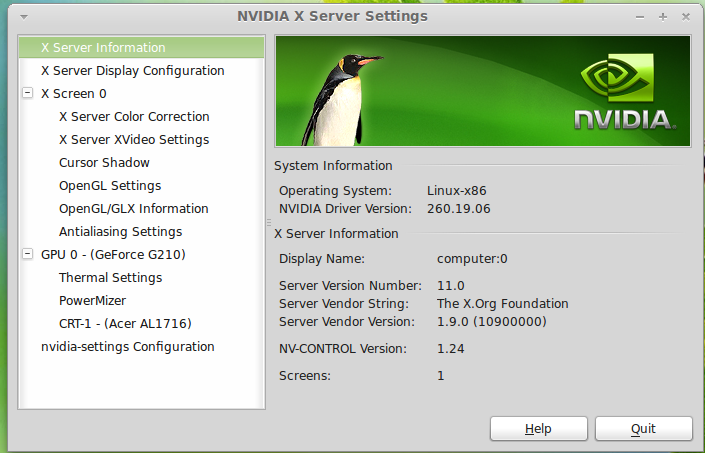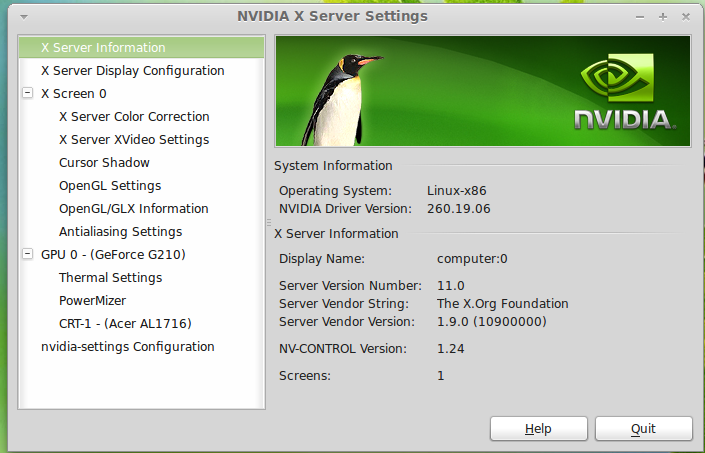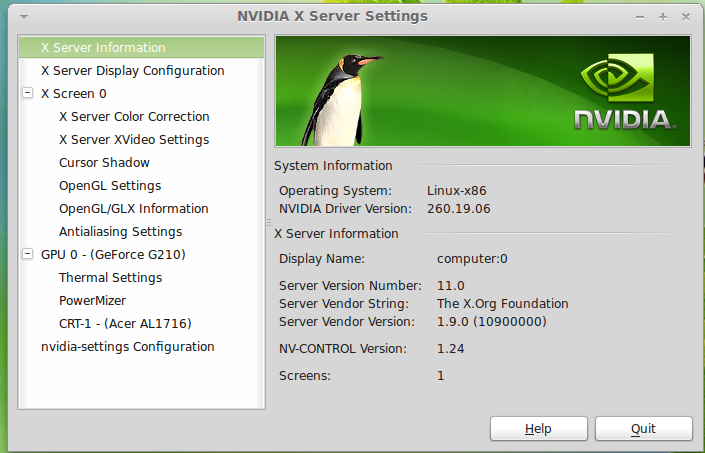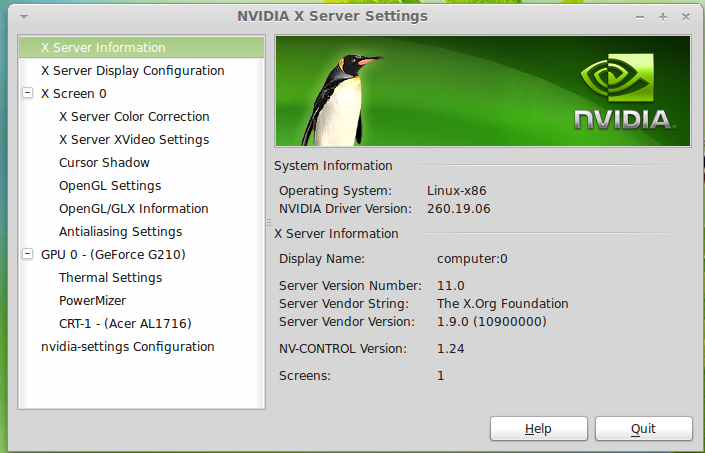Nvidia Solaris Legacy Display Driver is a freely distributed, native and proprietary 3D OpenGL video driver developed and published by Nvidia for their very old GPUs (Graphics Processing Units) running on Solaris operating systems. The driver is distributed in multiple editions, supporting a wide range of legacy Nvidia graphics cards.
Installing Nvidia Solaris Legacy Display Driver
In order to install the Nvidia Solaris Legacy Display Driver on your computer running a Solaris operating system, you must first download the respective driver for your graphics card from the Downloads section above. Make sure that the kernel headers are installed, save the run file on your Home directory, open a terminal and execute the “sh ./NVIDIA-Solaris-x86-xxx.xx.run” command as root, where xxx.xx is the version number or the driver.
During the installation, you will be asked if you want to let the installer automatically detect the optimal settings for your graphics card or if you want to manually edit the X configuration file. To make the Nvidia graphics driver the default for your Solaris operating system, run the “nvidia-xconfig” command in an X11 terminal emulator after installation. Both 64-bit and 32-bit architectures are supported at this time.
What legacy Nvidia cards are supported by this driver?
The Nvidia Solaris Legacy Display Drivers is distributed in three main branches, including the 304.xx series, 96.43.xx series and 173.14.xx series. Each of the aforementioned branches come with support for a specific range of graphics cards, which have been released by Nvidia in different periods of time, some of them 10 years ago, others 5 years ago. To see if your legacy Nvidia video card is supported by a certain driver, go to the downloads page of Nvidia and access the Supported Products tab of the respective video driver.
What is new in this release:
- Added support for X.Org xserver ABI 24 (xorg-server 1.20).
- Improved nvidia-bug-report.sh to check for kern.log which is the default kernel log-file location for many Debian-based Linux distributions.
- Fixed a bug which could cause X servers that export a Video Driver ABI earlier than 0.8 to crash when running X11 applications which call XRenderAddTraps().
What is new in version 340.106:
- Improved compatibility with recent Linux kernels, including Page Table Isolation (PTI) changes.
What is new in version :
- Added support for X.Org xserver ABI 23 (xorg-server 1.19)
What is new in version 340.96:
- Fixed a bug that could cause texture corruption in some OpenGL applications when video memory is exhausted by a combination of simultaneously running graphical and compute workloads.
- Added support for X.Org xserver ABI 20 (xorg-server 1.18).
What is new in version 340.93:
- Fixed a bug that caused the X server to crash if an OpenGL application tried to allocate a drawable when GPU-accessible memory is exhausted.
- Fixed a bug that could cause an Xid error when terminating a video playback application using the overlay presentation queue in VDPAU.
- Updated nvidia-installer to avoid recursing too deeply into kernel source trees under /usr/lib/modules, mirroring an existing restriction on recursion under /lib/modules.
- Fixed a rare deadlock condition when running applications that use OpenGL in multiple threads on a Quadro GPU.
- Fixed a kernel memory leak that occurred when looping hardware- accelerated video decoding with VDPAU on Maxwell-based GPUs.
- Fixed a bug that caused the X server to crash if a RandR 1.4 output provided by a Sink Output provider was selected as the primary output on X.Org xserver 1.17 and higher.
- Fixed a bug that caused waiting on X Sync Fence objects in OpenGL to hang indefinitely in some cases.
- Fixed a bug that prevented OpenGL from properly recovering from hardware errors or sync object waits that had timed out.
- Updated nvidia-installer to use modprobe(8) when leaving the NVIDIA kernel module loaded after installation, instead of insmod(8) or libkmod. This allows the kernel module to honor any configuration directives that apply to it in /etc/modprobe.d when it is loaded.
- Fixed a bug that allowed console messages from the Linux kernel to be drawn over the user interface of nvidia-installer.
What is new in version 340.76:
- Fixed a bug that caused frequent AMD-Vi page faults on systems with some AMD 8xx/9xx-series chipsets when used with some NVIDIA GPUs.
- Fixed a regression that could cause system crashes when terminating the X server on systems with an NVIDIA Quadro SDI Capture card installed.
- Fixed a bug that caused audio over HDMI to not work on some GPUs while using a display that supports HDMI 3D.
What is new in version 304.123:
- Fixed an interaction problem with xserver 1.15 that occasionally caused OpenGL applications to continue rendering when they are minimized or unmapped.
- Added support for X.org xserver ABI 18 (xorg-server 1.16).
- Fixed a bug that caused corruption or blank screens on monitors that use EDID version 1.3 or older when they are connected via DisplayPort on graphics boards that use external DisplayPort encoders, such as the Quadro FX 4800.
What is new in version 304.119:
- Fixed a crash when using WebGL in Firefox with a Geforce 6 GPU.
What is new in version 173.14.38:
- Improved compatibility with recent kernels.
What is new in version 304.116:
- Updated nvidia-installer to consider the "libglamoregl.so" X loadable extension module to be in conflict with the NVIDIA OpenGL driver. This module can cause the NVIDIA libGL to be loaded into the same process (the X server) as the NVIDIA libglx.so extension module, which is not a supported use case.
- Improved compatibility with recent Linux kernels.
- Updated the NVIDIA OpenGL driver to write temporary files to $TMPDIR if it is set, instead of unconditionally writing to /tmp.
- Updated a fallback of writing temporary files to $HOME/.nvidia to use $HOME/.nv instead, as the latter path is already used for other NVIDIA driver related files.
What is new in version 304.108:
- Implemented workarounds for two Adobe Flash bugs by applying libvdpau commit ca9e637c61e80145f0625a590c91429db67d0a40 to the version of libvdpau shipped with the NVIDIA driver.
- Fixed a bug in nvidia-settings that could cause the wrong resolution to be set in basic mode for setups based on one display per X screen.
What is new in version 173.14.37:
- Removed a spurious dependency on libpangox from the nvidia-settings binary shipped as part of the driver package.
- Added support for X.org xserver ABI 14 (xorg-server 1.14).
- Fixed font rendering performance and corruption problems on X servers with backported support for the new glyph cache functionality added to Pixman 0.27.
What is new in version 304.88:
- Fixed CVE-2013-0131: NVIDIA UNIX GPU Driver ARGB Cursor Buffer Overflow in "NoScanout" Mode. This buffer overflow, which occurred when an X client installed a large ARGB cursor on an X server running in NoScanout mode, could cause a denial of service (e.g., an X server segmentation fault), or could be exploited to achieve arbitrary code execution.
What is new in version 304.84:
- Fixed a bug that could lead to rendering corruption after an X server generation (i.e., leaving an X server running after all of its clients have exited).
- Removed a spurious dependency on libpangox from the nvidia-settings binary shipped as part of the driver package.
- Fixed a bug that could cause the X server to crash when performing an RandR 1.0 rotation (e.g., `xrandr --orientation left`) after unplugging the last connected monitor.
- Fixed a bug that caused the nvidia-xconfig(1) man page to be blank.
- Added support for X.org xserver ABI 14 (xorg-server 1.14).
- Fixed font rendering performance and corruption problems on X servers with backported support for the new glyph cache functionality added to Pixman 0.27.
- Fixed a potential X server crash during initialization, when a graphics card with a TV connector has no TV connected.
- Added a new X configuration option, "UseHotplugEvents", to allow the suppression of RandR events when adding or removing non-DisplayPort displays. See the "X Config Options" appendix of the README for details.
What is new in version 173.14.36:
- Added support for xserver ABI 13 (xorg-server 1.13).
What is new in version 96.43.21:
- Fixed a bug that caused the X server to fail to start.
What is new in version 304.64:
- Fixed a regression in backlight control functionality on some notebook configurations.
- Fixed a bug that sometimes prevented the display device / X screen selection menu from being displayed in nvidia-settings.
- Fixed a bug that prevented X driver gamma manipulation from working after a VT-switch on some configurations.
- Added the option "--output-file" to nvidia-bug-report.sh to allow specifying a custom filename for the log file.
- Fixed a hang when using OpenGL programs with some SLI Mosaic configurations on pre-Fermi GPUs.
- Added sections to the "Supported NVIDIA GPU Products" list for NVS, Tesla, and VGX products.





Comments not found